Soyuz (spacecraft)
- For the launch vehicle of the same name see Soyuz (rocket family)
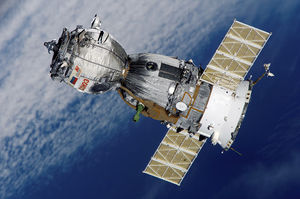 Soyuz spacecraft (TMA version) |
|
| Mission type | Used to carry personnel to and from the Salyut, Mir and International Space Station. Intended originally for Low Earth Orbit(LEO) missions. |
|---|---|
| Mission duration | Up to six months docked at a space station |
| Dimensions |
|
Soyuz (Russian: Сою́з, IPA: [sɐˈjus]), Union) is a series of spacecraft designed for the Soviet space program by the Korolyov Design Bureau. The Soyuz succeeded the Voskhod spacecraft and was originally built as part of the Soviet Manned Lunar program.
The Soyuz spacecraft is launched by the Soyuz rocket, the most frequently used and the most reliable launch vehicle in the world.[1][2] The Soyuz rocket was initially a part of the Soyuz program, and was a part of the unmanned Zond program.
The first unmanned Soyuz mission was launched November 28, 1966; the first Soyuz mission with a crew (Soyuz 1) was launched April 23, 1967, but the cosmonaut on board, Vladimir Komarov, died during the flight's crash-landing. Soyuz 2 was an unmanned mission, and Soyuz 3, launched on October 26, 1968, was the first successful Soyuz manned mission.
Currently, the Soyuz spacecraft family is still in service.[3] Soyuz spacecraft were used to carry cosmonauts to and from Salyut and later Mir Soviet space stations, and are now used for transport to and from the International Space Station. The International Space Station maintains docked Soyuz spacecraft at all times to be used as escape craft in the event of an emergency.
Contents |
Design

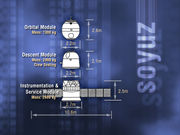
A Soyuz spacecraft consists of three parts (from front to back):
- A spheroid orbital module, which provides accommodation for the crew during their mission;
- A small aerodynamic reentry module, which returns the crew to Earth;
- A cylindrical service module with solar panels attached, which contains the instruments and engines.
The orbital and service modules are single-use and are destroyed upon re-entry in the atmosphere. The orbital and reentry portions are habitable living space. By moving as much equipment as possible into the orbital module, which does not have to be shielded or decelerated during atmospheric re-entry, the Soyuz is both larger and lighter than the contemporary Apollo spacecraft's command module. The Apollo command module had six cubic meters of living space and a mass of 5000 kg; the three-part Soyuz provides the same crew with nine cubic meters of living space, an airlock, and a service module for the mass of the Apollo capsule alone.
Soyuz can carry up to three crew members and provide life support for them for about 30 person days. The life support system provides a nitrogen/oxygen atmosphere at sea level partial pressures. The atmosphere is regenerated through KO2 cylinders, which absorb most of the CO2 and water produced by the crew and regenerates the oxygen, and LiOH cylinders which absorb leftover CO2.
The vehicle is protected during launch by a nose fairing, which is jettisoned after passing through the atmosphere. It has an automatic docking system. The ship can be operated automatically, or by a pilot independently of ground control.
Orbital Module

The forepart of the spacecraft is the orbital module (Russian: бытовой отсек (БО); Bytovoi otsek (BO)) also known as Habitation section. It houses all the equipment that will not be needed for reentry, such as experiments, cameras or cargo. The module also contains a toilet, docking avionics and communications gear. On the latest Soyuz versions, a small window was introduced, providing the crew with a forward view.
A hatch between it and the descent module can be closed so as to isolate it to act as an airlock if needed, cosmonauts exiting through its side port (near the descent module). On the launch pad, the astronauts enter the spacecraft through this port.
This separation also lets the orbital module be customized to the mission with less risk to the life-critical descent module. The convention of orientation in zero gravity differs from that of the descent module, as cosmonauts stand or sit with their heads to the docking port.
Reentry Module

The reentry module (Russian: спускаемый аппарат (СА); Spuskaemyi apparat (SA)) is used for launch and the journey back to Earth.Half of the reentry module is covered by a heat-resistant covering to protect it during re-entry.One half is heavier than the other,so the heavier side is facing the earth during re-entry,therefore shielding the module without having to cover the whole module. It is slowed initially by the atmosphere, then by a braking parachute, followed by the main parachute which slows the craft for landing. At one meter above the ground, solid-fuel braking engines mounted behind the heat shield are fired to give a soft landing. One of the design requirements for the reentry module was for it to have the highest possible volumetric efficiency (internal volume divided by hull area). The best shape for this is a sphere, but such a shape can provide no lift, which results in a purely ballistic reentry. Ballistic reentries are hard on the occupants due to high deceleration and cannot be steered beyond their initial deorbit burn. That is why it was decided to go with the "headlight" shape that the Soyuz uses—a hemispherical forward area joined by a barely angled conical section (seven degrees) to a classic spherical section heat shield. This shape allows a small amount of lift to be generated due to the unequal weight distribution. The nickname was thought up at a time when nearly every headlight was circular.
Service Module

At the back of the vehicle is the service module (Russian: приборно-агрегатный отсек (ПАО); Priborno-Agregatnyi Otsek (PAO)). It has a pressurized container shaped like a bulging can (Instrumentation compartment, PO (Priborniy Otsek) that contains systems for temperature control, electric power supply, long-range radio communications, radio telemetry, instruments for orientation and control. A non-pressurized part of the service module (Propulsion compartment, AO (Agregatniy Otsek)) contains the main engine and a spare: liquid-fuel propulsion systems for maneuvering in orbit and initiating the descent back to Earth. The ship also has a system of low-thrust engines for orientation, attached to the Intermediate compartment (PkhO or Perekhodnoi Otsek). Outside the service module are the sensors for the orientation system and the solar array, which is oriented towards the sun by rotating the ship.
Re-entry procedure
Because its modular construction differs from that of previous designs, the Soyuz has an unusual sequence of events prior to re-entry. The spacecraft is turned engine-forward and the main engine is fired for de-orbiting fully 180° ahead of its planned landing site. This requires the least propellant for re-entry, the spacecraft traveling on an elliptical Hohmann orbit to a point where it will be low enough in the atmosphere to re-enter.
Early Soyuz spacecraft would then have the service and orbital modules detach simultaneously. As they are connected by tubing and electrical cables to the descent module, this would aid in their separation and avoid having the descent module alter its orientation. Later Soyuz spacecraft detach the orbital module before firing the main engine, which saves even more propellant, enabling the descent module to return more payload. But in no case can the orbital module remain in orbit as an addition to a space station, for the hatch enabling it to function as an airlock is part of the descent module.
Re-entry firing is done on the "dawn" side of the earth, so that the spacecraft can be seen by recovery helicopters as it descends in the evening twilight, illuminated by the sun when it is above the shadow of the Earth. The Soyuz craft is designed to come down on land, usually somewhere in the deserts of Kazakhstan in central Asia. This is in contrast to early US manned missions which "splashed down" in the ocean.
Spacecraft systems
- Thermal Control System—Sistema Obespecheniya Teplovogo Rezhima, SOTR
- Life Support System—Kompleks Sredstv Obespecheniya Zhiznideyatelnosti, KSOZh
- Power Supply System—Sistema Elektropitaniya, SEP
- Communication and Tracking Systems—Rassvet (Dawn) radio communications system, Onboard Measurement System (SBI), Kvant-V spacecraft control, Klyost-M television system, Orbit Radio Tracking (RKO)
- Onboard Complex Control System—Sistema Upravleniya Bortovym Kompleksom, SUBK
- Combined Propulsion System—Kompleksnaya Dvigatelnaya Ustanovka, KDU
- Chaika-3 Motion Control System (SUD)
- 'Optical/Visual Devices (OVP)—VSK-4 (Vizir Spetsialniy Kosmicheskiy-4),Night Vision Device (VNUK-K, Visir Nochnogo Upravleniya po Kursu), Docking light, Pilot's Sight (VP-1, Vizir Pilota-1), Laser Range Finder (LPR-1, Lazerniy Dalnomer-1)
- Kurs rendezvous system
- Docking System—Sistema Stykovki i Vnutrennego Perekhoda, SSVP
- Teleoperator Control Mode—Teleoperatorniy Rezhim Upravleniya, TORU
- Entry Actuators System—Sistema Ispolnitelnikh Organov Spuska, SIO-S
- Landing Aids Kit—Kompleks Sredstv Prizemleniya, KSP
- Portable Survival Kit—Nosimiy Avariyniy Zapas, NAZ, containing a TP-82 or other pistol
- Soyuz Launch Escape System—Sistema Avariynogo Spaseniya, SAS
Variants
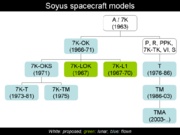


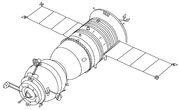

The Soyuz spacecraft has been the subject of continuous evolution since the early 1960s. Thus several different actual versions, proposals and projects exist.
Technical data
| Version: | Soyuz A (1963) | Soyuz 7K-OK (1967–1971) | Soyuz 7K-L3 (LOK) | Soyuz 7K-T (1973–1981) | Soyuz 7K-TM (1975) | Soyuz-T (1976–1986) | Soyuz-TM (1986–2002) | Soyuz-TMA (2003–.... ) |
| Total | ||||||||
|---|---|---|---|---|---|---|---|---|
| Mass (kg) | 5 880 | 6 560 | 9 850 | 6 800 | 6 680 | 6 850 | 7 250 | 7 220 |
| Length (m) | 7.40 | 7.95 | 10.06 | 7.48 | 7.48 | 7.48 | 7.48 | 7.48 |
| Max Diameter (m) | 2 .50 | 2 .72 | 2 .930 | 2 .72 | 2 .72 | 2 .72 | 2 .72 | 2 .72 |
| Span (m) | ? | 9 .80 | ? | 9 .80/– | 8 .37 | 10 .6 | 10 .6 | 10 .7 |
| Orbital Module (BO) | ||||||||
| Mass (kg) | 1 000 | 1 100 | - | 1 350 | 1 224 | 1 100 | 1 450 | 1 370 |
| Length (m) | 3 .00 | 3 .45 | 2 .26 | 2 .98 | 3 .10 | 2 .98 | 2 .98 | 2 .98 |
| Diameter (m) | 2 .20 | 2 .25 | 2 .3 | 2 .26 | 2 .26 | 2 .26 | 2 .26 | 2 .26 |
| Volume (m³) | 2 .20 | 5 .00 | - | 5 .00 | 5 .00 | 5 .00 | 5 .00 | 5 .00 |
| Reentry module (SA) | ||||||||
| Mass (kg) | 2 480 | 2 810 | 2 804 | 2 850 | 2 802 | 3 000 | 2 850 | 2 950 |
| Length (m) | 2 .30 | 2 .24 | 2 .19 | 2 .24 | 2 .24 | 2 .24 | 2 .24 | 2 .24 |
| Diameter (m) | 2 .17 | 2 .17 | 2 .2 | 2 .17 | 2 .17 | 2 .17 | 2 .17 | 2 .17 |
| Volume (m³) | 4 .00 | 4 .00 | - | 3 .50 | 4 .00 | 4 .00 | 3 .50 | 3 .50 |
| Service module (PAO) | ||||||||
| Mass (kg) | 2 400 | 2 650 | - | 2 700 | 2 654 | 2 750 | 2 950 | 2 900 |
| Usable mass (kg) | 830 | 500 | 3152[4] | 500 | 500 | 700 | 880 | 880 |
| Length (m) | 2 .10 | 2 .26 | 2 .82 | 2 .26 | 2 .26 | 2 .26 | 2 .26 | 2 .26 |
| Diameter (m) | 2 .50 | 2 .72 | 2 .2 | 2 .72 | 2 .72 | 2 .72 | 2 .72 | 2 .72 |
Soyuz A (part of the "circumlunar complex") (1963)
Korolyov initially promoted the Soyuz A-B-C circumlunar complex (7K-9K-11K) concept (also known as L1) in which a two-man craft Soyuz-A 7K would rendezvous with other components (9K and 11K) in Earth orbit to assemble a lunar excursion vehicle, the components being delivered by the proven R-7 rocket.
First generation
The manned Soyuz spacecraft can be classified into design generations. Soyuz 1 through Soyuz 11 (1967–1971) were first-generation vehicles, carrying a crew of up to three without spacesuits and distinguished from those following by their bent solar panels and their use of the Igla automatic docking navigation system, which required special radar antennas. This first generation was called Soyuz 7K-OK and encompassed the original Soyuz and Salyut 1 Soyuz.
The Soyuz 7K-L1 was designed to launch men from the Earth to circle the moon, and was the primary hope for a Soviet circumlunar flight. It had several test flights in the Zond program from 1967–1970 (Zond 4 to Zond 8), which produced multiple failures in the 7K-L1's re-entry systems. So the remaining 7K-L1s were scrapped. The Soyuz 7K-L3 was designed and developed in parallel to the Soyuz 7K-L1, but was also scrapped.
The next manned version of the Soyuz was the Soyuz 7K-OKS. It was designed for space station flights and had a docking port that allowed internal transfer between spacecraft. The Soyuz 7K-OKS had two manned flights, both in 1971, and the second of which depressurized upon re-entry, killing its three-man crew.
Second generation
The second generation, called Soyuz Ferry or Soyuz 7K-T, comprised Soyuz 12 through Soyuz 40 (1973–1981). It was developed out of the military Soyuz concepts studied in previous years. The Soyuz 7K-T/A9 version was used for the flights to the military Almaz space station.
Soyuz 7K-TM was the spacecraft used in the Apollo-Soyuz Test Project in 1975, which saw the first and only docking of a Soyuz spacecraft with an Apollo spacecraft. It was also flown in 1976 for the earth-science mission, Soyuz 22. Soyuz 7K-TM served as a technological bridge to the third generation, the Soyuz-T spacecraft.
Several military Soyuz models were planned, but none actually flew in space. These versions were named Soyuz 7K-P, Soyuz 7K-PPK, Soyuz R, Soyuz 7K-VI, and Soyuz OIS (Orbital Research Station).
Third generation
The third generation Soyuz-T (T: транспортный, Transportnyi meaning transport) spacecraft (1976–1986) featured solar panels allowing longer missions, a revised Igla rendezvous system and new translation/attitude thruster system on the Service module. It could carry a crew of three, now wearing spacesuits.
Fourth generation
The Soyuz-TM crew transports (M: модифицированный, Modifitsirovannyi meaning modified) were fourth generation Soyuz spacecraft, and were used from 1986 to 2003 for ferry flights to Mir and the International Space Station.
Soyuz-TMA (2003–.... )
Soyuz TMA (A: антропометрический, Antropometricheskii meaning anthropometric) features several changes to accommodate requirements requested by NASA in order to service the International Space Station, including more latitude in the height and weight of the crew and improved parachute systems. It is also the first expendable vehicle to feature "glass cockpit" technology. Soyuz-TMA looks identical to a Soyuz-TM spacecraft on the outside, but interior differences allow it to accommodate taller occupants with new adjustable crew couches.
Soyuz TMA-M (2010/....)
In 2004, Russian space officials announced that they intended to replace Soyuz with the new Kliper and Parom spacecrafts by early 2011.[5] Since then, Kliper appears to have been indefinitely postponed due to lack of government funding. It has since been announced that the Soyuz will receive an upgrade to make it suitable for up to one year in space, as well as new digital interior displays and updated docking equipment. This new version, known as Soyuz TMA-M, could enter service around 2010.[6]
Soyuz ACTS (2012/....)
Soyuz ACTS (Advanced Crew Transportation System), also known as Soyuz-K, is a proposed version of the Soyuz design capable of achieving lunar orbit. The upgrades could include a new habitation module developed by the European Space Agency. A novel, rocket-based precision landing system may also be implemented.[7] Missions could be launched from Baikonur or Guiana Space Centre.[8]
Related craft
The unmanned Progress spacecraft were derived from Soyuz and are used for servicing space stations.
While not being the direct derivatives of the Soyuz, the Chinese Shenzhou spacecraft and the Indian Orbital Vehicle follow the general template as pioneered by the Soyuz.
Operators
- Russian Federation: 24 August 1991 (independence of Russia from the USSR) to the present
- Union of Soviet Socialist Republics: 1966 to 26 December 1991 (Dissolution of the Soviet Union, by the dissolution of the Supreme Soviet)
See also
- Progress spacecraft
- Chinese Shenzhou spacecraft
- ISRO Orbital Vehicle
- Sokol space suit
- Space exploration
- Human spaceflight
- Crew Space Transportation System study to develop a European-Russian successor to Soyuz
- Zarya spacecraft project
Missions
See List of Soviet and Russian manned space missions as well as the Zond program
Image gallery
 Early 7K-OK Soyuz at National Space Centre, Leicester, England |
 Soyuz spacecraft of the Apollo Soyuz Test Project (ASTP) |
_spacecraft.jpg) Soyuz 19 spacecraft as seen from Apollo CM |
 Soyuz docked to Mir |
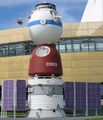 Soyuz spacecraft mock-up |
 Soyuz launch vehicles engines |
 Soyuz TM-31 Moves to Launch Pad, 29 October 2000 |
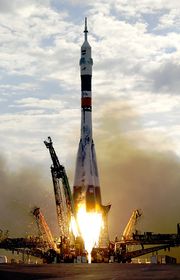 Soyuz TMA-2 launch, Baikonur, April 26, 2003 |
 Soyuz TMA-3 landing (NASA) |
 Space Shuttle Orbiter and Soyuz-TM (drawn to scale). |
 Soyuz spacecraft on display at the Kennedy Space Center. |
 Soviet Insignia on an older Soyuz spacecraft. |
 Astronauts within Soyuz trainer. |
References
- ↑ Soyuz launch vehicle: The most reliable means of space travel, ESA
- ↑ France and Russia agree: Soyuz will launch from Kourou in French Guyana, SpaceRef
- ↑ Soyuz rocket
- ↑ Lunar Orbital Spacecraft (LOK)
- ↑ http://www.spacedaily.com/reports/Soyuz_100_Times_More_Reliable_Than_Shuttle_999.html
- ↑ http://www.spacedaily.com/reports/Soyuz_100_Times_More_Reliable_Than_Shuttle_999.html
- ↑ [1]
- ↑ Advanced Crew Transportation System, ACTS
External links
- Russia New Russian spaceship will be able to fly to Moon - space corp
- RSC Energia: Concept Of Russian Manned Space Navigation Development
- Mir Hardware Heritage
- David S.F. Portree, Mir Hardware Heritage, NASA RP-1357, 1995
- Mir Hardware Heritage (wikisource)
- Information on Soyuz spacecraft
- OMWorld's ASTP Docking Trainer Page
- NASA - Russian Soyuz TMA Spacecraft Details
- Space Adventures circum-lunar mission - details
|
||||||||||||||||||||||||||||||||
|
|||||||||||
|
||||||||||
